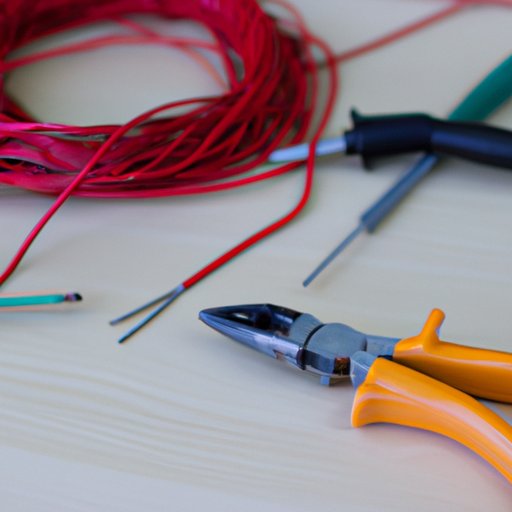Introduction
Soldering wires is an essential skill for many DIY projects and repairs. Whether you are fixing a broken electronic device or creating a custom circuit, proper soldering techniques are crucial for a successful outcome. This article aims to provide a comprehensive guide on how to solder wires for beginners. We will cover everything from the process to the tools required, common issues, comparison of soldering tools, and best practices.
Step-by-Step Guide
Soldering wires involves joining two or more wires by melting a metal alloy, called solder, and fusing them together. Here are the step-by-step instructions for soldering wires:
- Prepare the wires by stripping off 1/2 inch of insulation from the ends using wire strippers.
- Twist the exposed wires together to form a tight and secure connection.
- Clean the joint with a wire brush to remove any dirt or oxidation.
- Heat the joint with a soldering iron until it is hot enough to melt the solder.
- Apply a small amount of solder to the joint, and allow it to flow evenly and completely around the wires.
- Remove the heat and let the solder cool and solidify before moving the wires.
It is essential to work in a well-ventilated area and avoid inhaling the fumes from the solder. Also, remember to handle the soldering iron carefully as it can get hot and cause burns.
Video Tutorial
We have also prepared a video tutorial as a visual guide to help you better understand the process of soldering wires. Before watching the video, take note of the tools required:
- Soldering iron
- Solder
- Wire strippers
- Wire brush
Troubleshooting Common Issues
Despite following the steps correctly, you may encounter some common issues when soldering wires. Here are some tips to help you troubleshoot:
- If the wires do not get hot enough to melt the solder, try cleaning the joint and applying some flux before heating it again.
- If the solder does not flow evenly or completely around the wires, you may need to apply more heat and ensure that the wires are in close contact.
- If the wires do not stick together, double-check if they are aligned correctly and in proper contact with each other.
Comparison of Soldering Tools
There are several types of soldering tools available for soldering wires, each with its advantages and disadvantages. Here is a comparison of the most common types:
- Soldering Iron – This is the most common tool used for soldering wires due to its versatility and low cost. However, it may not be suitable for delicate or intricate work.
- Soldering Gun – A soldering gun is a powerful tool that heats up quickly and suitable for heavy-duty work. However, it may damage delicate wires due to the intense heat.
- Soldering Station – A soldering station is a more advanced tool that provides better control over the temperature and is suitable for delicate work. However, it is more expensive compared to other options.
When choosing a soldering tool, consider the type of work you will be doing and your level of experience. It is best to invest in a quality soldering tool that can last for years and provide consistent results.
Best Practices
Here are some best practices to keep in mind when soldering wires:
- Always work in a clean and well-lit area to avoid accidents or mistakes.
- Use proper safety equipment such as goggles and gloves to protect yourself from burns, fumes, and other hazards.
- Choose the right type of solder and flux for your job and ensure that they are compatible with each other.
- Handle the soldering iron with care and avoid touching the hot tip with your bare hands.
- Keep the wires still and in proper contact while soldering to avoid cold joints or loose connections.
- Avoid using too much solder as it may cause the joint to become weak or breakable.
- Practice and experiment with different types of wires and techniques to improve your skills and confidence in soldering.
Conclusion
Soldering wires may seem daunting at first, but with the right tools and techniques, it can be a straightforward and enjoyable process. Remember to follow the step-by-step guide, watch the video tutorial, troubleshoot common issues, compare different soldering tools, and adopt best practices for the best results. Do not be afraid to experiment and try new things, and most importantly, enjoy the process of creating and repairing.
